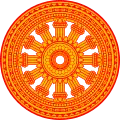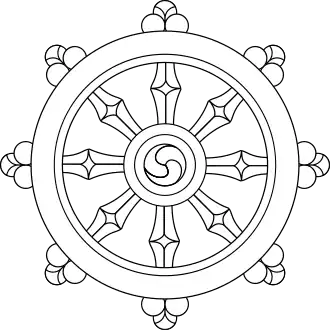Maha Nikaya
| Part of a series on |
| Theravāda Buddhism |
|---|
 |
| Buddhism |
Maha Nikaya (Thai: มหานิกาย) is the name for a sect or order of Buddhist monastics in Thailand of the Theravada Lankavamsa sect.[1] It is one of the two main monastic orders of Thailand, the other being the Dhammayuttika Nikaya. The Maha Nikaya is the larger of the two, comprising over 90% of all monks in Thailand.[2]
Origins and Meaning
The term *Maha Nikaya* comes from the Pali roots *mahanta* + *nikaya*, meaning “the greater group.” In practice, it refers to the mainstream Theravāda monastic lineage of Thailand, which developed from the Lankavamsa (Sri Lankan) tradition introduced to Southeast Asia. Historically, all Theravāda monks in Thailand followed this lineage until the formation of the Dhammayuttika order in the 19th century.
Background of the Lankavamsa Tradition
Around 236 B.E., Ashoka the Great sponsored the Third Buddhist Council, sending missions abroad. One mission went to Sri Lanka, where Theravāda Buddhism flourished. In the 12th century, King Parakramabahu I of Sri Lanka reformed the Sangha, unifying it into the Lankavamsa lineage. This reformed order spread to neighboring regions, including Burma and later Thailand.[3]
Continuation in Pagan (Bagan)
The reputation of Lanka’s reforms reached Burma during the reign of King Narapati Sithu of Pagan. He invited the monk Shin Uttarajiva to Lanka in B.E. 1733. His disciple, Chapada, ordained in the Lankan lineage and later returned with four other learned monks. These elders established the strict Lankavamsa tradition in Burma, distinct from local practices, and gained royal patronage.
Transmission to Thailand
The Lankavamsa Theravāda order entered Nakhon Si Thammarat during the reign of King Ramkhamhaeng of Sukhothai..[4] The city became an important religious center, spreading the lineage throughout Thailand. By the Sukhothai and Ayutthaya periods, this tradition—later called Maha Nikaya—was the dominant clerical order, supported by royal patronage, scripture preservation, and temple building.[5]
Division with the Dhammayuttika Nikaya
In the early Rattanakosin period, Prince Mongkut (later King Rama IV) observed what he regarded as lax monastic discipline among mainstream monks. In 1833 he founded the Dhammayuttika Nikaya as a stricter reform order. Thereafter, all other monks were collectively designated as the Maha Nikaya (“the great collection”).[6]
In reality, the Maha Nikaya encompasses a wide variety of local traditions and practices, unified mainly by not belonging to the Dhammayuttika. While Dhammayuttika monks have received strong royal support, the Maha Nikaya remains the vast majority.
Maha Nikaya in Cambodia
A similar situation developed in Cambodia, where the Dhammayuttika order was introduced from Thailand in 1855. Those not joining the reform were recognized as the Maha Nikaya (Khmer: មហានិកាយ Mohanikay). King Norodom appointed a separate supreme patriarch for the Dhammayuttika order, while the existing patriarch became head of the Cambodian Maha Nikaya. Today, the Maha Nikaya remains the dominant clerical order in Cambodia.
Modern Administration
In Thailand, a single Supreme Patriarch of Thailand has authority over both the Maha Nikaya and the Dhammayuttika Nikaya. However, controversy has arisen because recent patriarchs have almost always been chosen from the minority Dhammayuttika order, despite its representing only around 6% of Thai monks. Some Maha Nikaya monks have campaigned for the creation of a separate patriarch for their order.[7]
Missionary Works
Maha Nikaya monks have actively spread Theravāda Buddhism to Laos, Cambodia, and parts of Myanmar. In modern times, they have established temples and centers in Europe, North America, and Australia, serving Thai expatriates and promoting Buddhist teachings abroad.[8]
Robe-Wearing Practices
Maha Nikaya monks wear saffron-colored robes. Their robe style typically leaves one shoulder bare during certain activities, while Dhammayuttika monks more often keep both shoulders covered. Despite differences in discipline, both orders share the same core Theravāda teachings.[9]
See Also
- Dhammayuttika Nikaya
- Theravada Buddhism in Thailand
- Sangha Supreme Council of Thailand
- Supreme Patriarch of Cambodia
- Supreme Patriarch of Thailand
- Mahanayaka
- Nikaya
- Sangharaja
References
- ^ "Thai Buddhism". Retrieved 2008-06-16.
- ^ Swearer, Donald K. (2010). The Buddhist World of Southeast Asia. SUNY Press. p. 101. ISBN 9780791479385.
{{cite book}}: Check|isbn=value: checksum (help) - ^ Kate Crosby (2014). "Theravāda Buddhism: Continuity, Diversity, and Identity". Journal of Southeast Asian Studies. 45 (2): 274–298. doi:10.1017/S002246341400017X.
- ^ "Nakhon Si Thammarat – Encyclopaedia Britannica". Retrieved 2023-08-15.
- ^ Swearer, Donald K. (2010). The Buddhist World of Southeast Asia. SUNY Press. p. 104.
- ^ Ishii, Yoneo (1986). Sangha, State, and Society: Thai Buddhism in History. University of Hawaii Press. p. 45. ISBN 9780824810504.
- ^ "The politics of Thailand's Buddhist Supreme Patriarch". Channel News Asia. Archived from the original on 2017-09-07. Retrieved 2017-05-20.
- ^ Harris, Ian (2012). Buddhism in a Dark Age: Cambodian Monks under Pol Pot. University of Hawaii Press. p. 12. ISBN 9780824836061.
- ^ Tambiah, Stanley J. (1970). Buddhism and the Spirit Cults in North-East Thailand. Cambridge University Press. p. 35.
- Swearer, Donald K. (2010). The Buddhist World of Southeast Asia. State University of New York Press.
- Tambiah, Stanley J. (1976). World Conqueror and World Renouncer. Cambridge University Press.
- Damrong Rajanubhab, Prince. Travels in Burma: On the Arrival of the Lankavamsa Sangha in Thailand from Pagan. Bangkok: Matichon, 2002.
- Devaprabas Makklai. (2008). Local Studies: Traditions, Culture, and Historical Development of Wat and Khung Taphao Village. Uttaradit: Wat Khung Taphao.
